Abstract
Introduction:
Determining the age of a person in the absence of documentary evidence of birth is essential for legal and medico-legal purpose. Fishman method of skeletal maturation is widely used for this purpose; however, the reliability of this method for people with all geographic locations is not well-established.
Aims and Objectives:
In this study, we assessed various stages of carpal and metacarpal bone maturation and tested the reliability of Fishman method of skeletal maturation to estimate the age in South Indian population. We also evaluated the correlation between the chronological age (CA) and predicted age based on the Fishman method of skeletal maturation.
Materials and Methods:
Digital right hand-wrist radiographs of 330 individuals aged 9-20 years were obtained and the skeletal maturity stage for each subject was determined using Fishman method. The skeletal maturation indicator scores were obtained and analyzed with reference to CA and sex. Data was analyzed using the SPSS software package (version 12, SPSS Inc., Chicago, IL, USA).
Results:
The study subjects had a tendency toward late maturation with the mean skeletal age (SA) estimated being significantly lowers (P < 0.05) than the mean CA at various skeletal maturity stages. Nevertheless, significant correlation was observed in this study between SA and CA for males (r = 0.82) and females (r = 0.85). Interestingly, female subjects were observed to be advanced in SA compared with males.
Conclusion:
Fishman method of skeletal maturation can be used as an alternative tool for the assessment of mean age of an individual of unknown CA in South Indian children.
Keywords: Age estimation, chronological age, forensic radiology, hand-wrist radiograph, skeletal age
INTRODUCTION
Radiological images are essential tools in age determination in forensic science. However, this technique is also useful when a birth certificate is not available and records are suspected. Human beings show considerable variations during growth, but show certain patterns, which has led to the concept of assessing biological or physiological maturity. Accurate assessment of chronological age (CA) is provided by developmental stages such as skeletal maturation, secondary sexual characters and dental development.[1] The degree of skeletal development reflects the degree of physiological maturation, which is judged on the basis of degree of bone ossification.[2] Skeletal maturity is a measure of development basing on the size, shape and degree of mineralization of bone to define its proximity to full maturity and can be seen radiologically. The sequence of changes is relatively consistent for a given bone in every person. However, the timing of these changes varies because each person has his or her own biological clock.[3] The use of skeletal age (SA) has been shown to be more reliable and precise than CA in assessing the progress of an individual toward maturity. Skeletal maturity is influenced in each individual by a combination of genetic factors, environmental conditions, socio-economic status, nutrition and health status.[4,5] Skeletal maturation assessed on hand-wrist radiographs is classically considered as the best indicator of maturity and has been found to be closely related to the growth spurt.
Biological age, SA, bone age and skeletal maturation are nearly synonymous terms used to describe the stages of maturation of a person.[2] SA or bone age are the most common measure for biological maturation of the growing human and can be derived from the examination of successive stages of skeletal development as viewed in hand-wrist radiographs. This is currently the only available indicator of development that spans the entire growth period, from birth to maturity. The technique for assessing SA consists of visual inspection of bones, their initial appearance and their subsequent ossification changes in shape and size. Basically, three common approaches are used in the past to assess the hand-wrist radiographs. First was the atlas system involved the matching of a hand-wrist radiograph with a standard series of chronologically oriented radiographic images. A second assessment variation involved matching features of many individual bones and then assigning point scores to the stages revealed. Third method emphasized alteration in bony shapes and establishes ratios between linear measurements of the long bones of the hand and wrist; the grading of the indicators and ratios was then calculated to determine the SA.[6,7]
Fishman developed a system of skeletal maturation assessment based upon skeletal maturity indicators (SMI) demonstrated on hand-wrist radiographs for the assessment of the pubertal growth spurt. This sequence of events provides a methodological approach for identifying specific maturational stages that cover the entire adolescent period. The SMI is an organized and relatively simple way to observe skeletal maturity: It uses 11 anatomical sites on the phalanges, adductor sesamoid and radius, excluding the carpal bones.[4,5]
Objectives of this study
To assess the maturation of carpal and metacarpal bones to estimate SA in young adults and adolescents at different ages
To test the reliability of Fishman method for age determination in South Indian population
To assess whether the estimated SA correlates with the CA.
MATERIALS AND METHODS
The study consisted of 330 randomly selected subjects (165 males and 165 females) aged 9-20 years, divided into 11 groups [Table 1]. Informed consent was taken from all the individuals participated and the study was approved by the ethical committee of GITAM Dental College and Hospital, Visakhapatnam, Andhra Pradesh, India. Patients with serious medical illness, history of trauma to hand and wrist region were excluded from the study.
Table 1.
Distribution of the sample according to age and sex
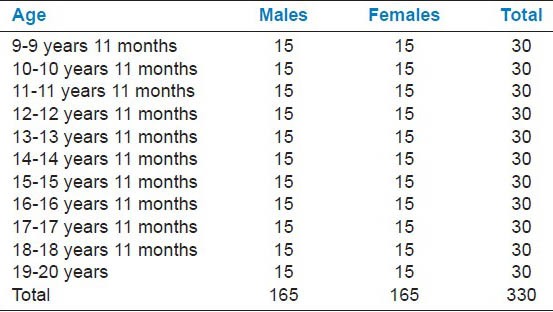
Clinical examination of subjects was performed, patient details and date of X-ray was recorded. 330 right hand-wrist digital radiographs were taken with a Planmeca promax digital machine. CA of an individual was calculated by subtracting the birth date from the date on which the radiographs were exposed for that particular individual. Decimal age was taken for simplicity of statistical calculation and ages were estimated on a yearly basis (For example, 9 years 9 months as 9.09 years and it was considered in 9 years age group). To avoid observer bias, each digital hand-wrist of an individual was coded with only a numerical Identity number (1-330) to ensure that the examiners were blind to sex, name and age of subjects. Three examiners (one maxillofacial radiologist and two orthodontists) were given compact discs of images and instructed to complete staging for all images and relevant age for all individuals. To test intraexaminer reliability, each examiner unknowingly re-evaluated 20 of their images after 1 month.
Assessment of staging of skeletal maturation using SMIs from hand-wrist radiograph with Fishman method
To evaluate the maturational patterns of the indicators in the hand-wrist, Fishman's (1982)[5] eleven-grade system was used [Table 2]. Eleven discrete adolescent skeletal maturational indicators covering the entire period of adolescent development is found on these six sites [Figure 1]. A systematic observational scheme [Figure 2] was used to facilitate SMI evaluation. Referring with this approach, key stages were checked first. A useful first step was to determine the detection of adductor sesamoid of the thumb or alternatively presence of early epiphyseal widening rather than capping. If the sesamoid was visible, then either the sesamoid or an SMI based on capping or fusion was applicable. Skeletal maturity was converted in to SA by using specific tables [Table 3].[5,15]
Table 2.
Skeletal maturity indicators [Fishman]
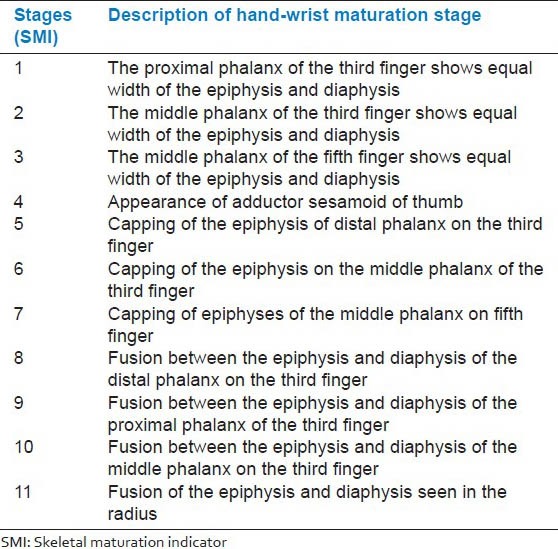
Figure 1.

Eleven skeletal maturity indicators
Figure 2.

Observational scheme for assessing skeletal maturation indicator's on a hand-wrist radiograph
Table 3.
Assessment of skeletal age from hand-wrist maturation stages
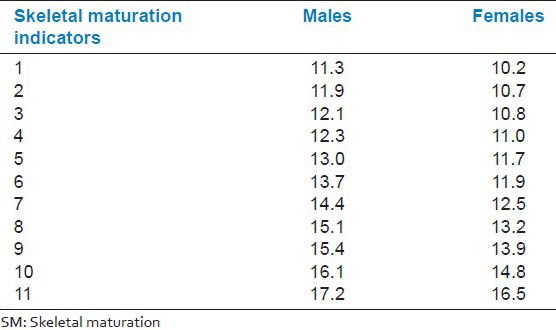
Statistical analysis
Data was analyzed using the SPSS software package (version 12, SPSS Inc., Chicago, IL, USA). The significance of the difference between the means of different ages was determined using a paired sample t-test. Pearson's correlation between means of different ages was also calculated. Felli's Kappa statistics was performed to test interobserver variability.
RESULTS
The sample consisted of 165 males and 165 females whose ages ranged from 9 to 20 years. The SMI scores were obtained and analyzed with reference to CA and gender. In males, mean values of actual age did not differ significantly from mean values of age derived from hand-wrist in all age groups except in Groups 4, 6,7 (P > 0.05). In males, mean age for initiation of skeletal maturation commenced around 11.5 ± 0.5 years and completed around 16.9 years [Table 4] while in females mean age for initiation of skeletal maturation commenced around 10 years and completed at 16 years [Table 5] indicating females mature earlier than males [Graphs 1 and 2].
Table 4.
Comparison between SA using the Fishman method and CA (in years) in males

Table 5.
Comparison between SA using the Fishman method and CA (in years) in females

Graph 1.
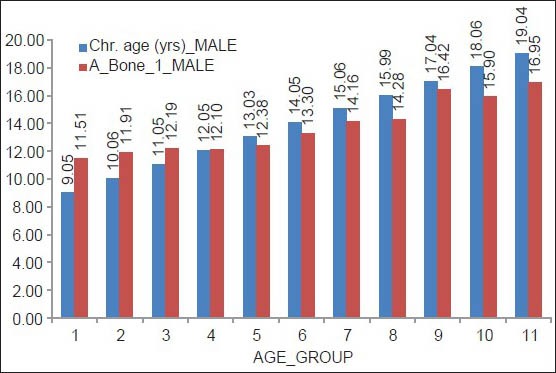
Correlation between chronological age and skeletal age in males (Abbreviation: A Bone1 means skeletal age (X-axis – age group, Y-axis –Mean values)
Graph 2.
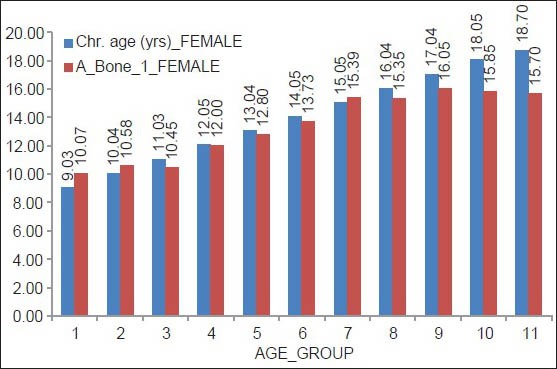
Correlation between chronological age and skeletal age in females (Abbreviation: A Bone1 means skeletal age. (X-axis-age group, Y-axis –Mean values)
Significant inter and intra-observer correlation coefficient of 98.5% and 98% was observed [Tables 6 and 7 respectively]. Significant correlation was observed between CA and SA in females (r = 0.85) and males (r = 0.82) [Table 8]. The reliability of intra and inter-examiner radiographic interpretation was indicated by the high correlation between readings recorded by the three different examiners.
Table 6.
Inter observer correlation (Cohen Kappa)

Table 7.
Intraobserver correlation (Pearson)
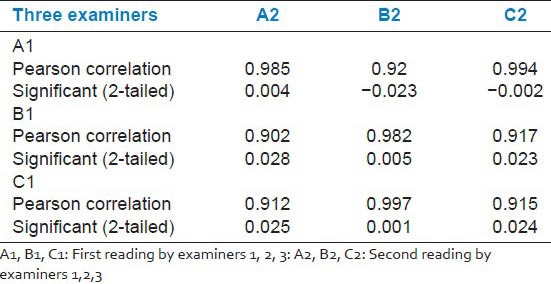
Table 8.
Pearson correlation between SA and CA for females and males
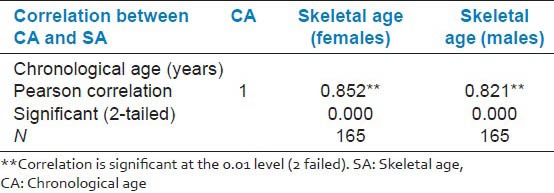
Mean CA in males and females was 14 ± 3.3 years and 14 ± 3.2 years respectively. Mean SA was underestimated in both males (13.7 ± 1.9 years) and females (13.4 ± 2.3 years) compared with CA. Fishman method underestimated the mean age of males and females by 0.4 and 0.3 years respectively [Table 9].
Table 9.
Descriptive statistics for the entire sample
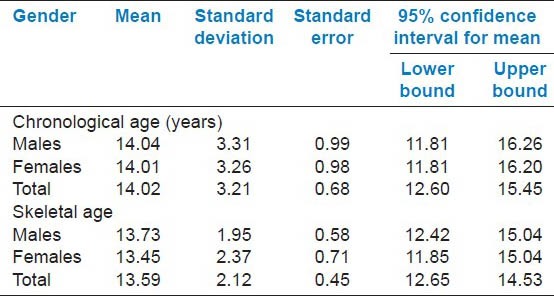
DISCUSSION
The present study was conducted with an aim to assess the SA of an individual by interpretation of hand-wrist radiograph and to correlate it with CA in South Indian population. Many investigators[5,8,9,10,11] have delineated several specific ossification stages that occur before, at or after peak height velocity. The identification of these skeletal maturation levels provides a useful means of identification of specific points along the progressive path of adolescent growth. Hand-wrist radiographs are used to indicate the stage of skeletal maturity and predict the onset of maximum pubertal growth. The coexistence of a large number of bony structures with distinct and yet predictable sequence of maturation has made hand-wrist radiographs a useful clinical tool to assess skeletal maturity.[12,13]
In this study, SA for each subject was assessed using hand-wrist radiograph according to the Fishman method.[4] This method offers an organized and relatively simple approach to determine the level of skeletal maturation from hand-wrist radiograph. We observed a significant difference between mean values of CA and SA in the entire sample indicating SA is advanced than CA. Our results are in concurrence with the previous reports[1,5,14,15,16,17] and suggest that South Indian children tend to be late maturers when CA is used as an index of skeletal maturity. Further our study indicated that females were advanced in skeletal maturation compared with males in all age groups, which is consistent with previous reports.[5,10,14,15,16,18,19,20]
In this study, when Fishman method of skeletal maturation was used to assess SA, mean difference between true and assessed age was found to be minimal for both males (0.4 years) and females (0.3 years). The simplicity of the Fishman method and the use of distinct and clear SMIs perhaps may have contributed to the high reproducibility of the readings in our study. Interestingly, significant correlation was observed between SA and CA in both males and females. Thus, SA assessment using Fishman method is a reliable technique for estimating age.
It is essential to note that in this study, the SA were derived from only a part of the skeleton, which may or may not be representative of whole skeleton and increased radiation exposure to an individual, which is further emphasized by International study Group on Forensic Age Diagnostics to consider alternative measures when necessary.[21] Importantly comprehensive age estimation should utilize all available methods when necessary, nevertheless hand-wrist maturation data compliments the individual maturational status to give a complete assessment of age.
CONCLUSION
Bones represent useful material for age estimation. Digital radiographic assessment of maturation of carpal and metacarpal bones can be used a reliable choice for predicting biological age. Fishman method of skeletal maturation can be reliably used to generate mean age and the estimated age range for an individual of unknown CA in South Indian population.
ACKNOWLEDGMENT
I sincerely thank Dr. Ahammad Basha, M.D. Assistant Professor, Dept. of Community Medicine for preparing statistical analysis for the study.
Footnotes
Source of Support: Nil
Conflict of Interest: None declared.
REFERENCES
- 1.Sachan K, Sharma VP, Tandon P. Correlative and comparative study of Fishman's skeletal maturity indicators with CVMI and chronological age in Lucknow population. Eur J Gen Dent. 2012;1:161–5. [Google Scholar]
- 2.Hassel B, Farman AG. Skeletal maturation evaluation using cervical vertebrae. Am J Orthod Dentofacial Orthop. 1995;107:58–66. doi: 10.1016/s0889-5406(95)70157-5. [DOI] [PubMed] [Google Scholar]
- 3.Mahajan S. Evaluation of skeletal maturation by comparing the hand wrist radiograph and cervical vertebrae as seen in lateral cephalogram. Indian J Dent Res. 2011;22:309–16. doi: 10.4103/0970-9290.84310. [DOI] [PubMed] [Google Scholar]
- 4.Soegiharto BM, Cunningham SJ, Moles DR. Skeletal maturation in Indonesian and white children assessed with hand-wrist and cervical vertebrae methods. Am J OrthodDentofacialOrthop. 2008;134:217–26. doi: 10.1016/j.ajodo.2006.07.037. [DOI] [PubMed] [Google Scholar]
- 5.Fishman LS. Radiographic evaluation of skeletal maturation. A clinically oriented method based on hand-wrist films. Angle Orthod. 1982;52:88–112. doi: 10.1043/0003-3219(1982)052<0088:REOSM>2.0.CO;2. [DOI] [PubMed] [Google Scholar]
- 6.Flores-Mir C, Burgess CA, Champney M, Jensen RJ, Pitcher MR, Major PW. Correlation of skeletal maturation stages determined by cervical vertebrae and hand-wrist evaluations. Angle Orthod. 2006;76:1–5. doi: 10.1043/0003-3219(2006)076[0001:COSMSD]2.0.CO;2. [DOI] [PubMed] [Google Scholar]
- 7.Shamsher Khan RM, Ijaz A. Correlation of dental calcification and skeletal maturity indicators. Annals. 2011;17:22–6. [Google Scholar]
- 8.Tanner JM, Whitehouse RH, Marshal WA, Healy MJ, Goldstein H. London: London Academic Press; 1975. Assessment of Skeletal Maturity and Prediction of Adult's Height (TW2 method) [Google Scholar]
- 9.Grave KC, Brown T. Skeletal ossification and the adolescent growth spurt. Am J Orthod. 1976;69:611–9. doi: 10.1016/0002-9416(76)90143-3. [DOI] [PubMed] [Google Scholar]
- 10.Hägg U, Taranger J. Menarche and voice change as indicators of the pubertal growth spurt. Acta Odontol Scand. 1980;38:179–86. doi: 10.3109/00016358009004718. [DOI] [PubMed] [Google Scholar]
- 11.Abdel-Kader HM. The reliability of dental x-ray film in assessment of MP3 stages of the pubertal growth spurt. Am J OrthodDentofacialOrthop. 1998;114:427–9. doi: 10.1016/s0889-5406(98)70188-x. [DOI] [PubMed] [Google Scholar]
- 12.Al-Hadlaq A, Hashim H, Al-Shalan T, Al-Hawwas A, Al-Mutairi N, Al-Zahrani T. Association between chronological and skeletal ages among a sample of Saudi male children. Saudi Dent J. 2007;19:1–7. [Google Scholar]
- 13.Todd TW. 1st ed. St.Louis: The CV Mosby Company; 1937. Atlas of Skeletal Maturation. [Google Scholar]
- 14.Fishman LS. Chronological versus skeletal age, an evaluation of craniofacial growth. Angle Orthod. 1979;49:181–9. doi: 10.1043/0003-3219(1979)049<0181:CVSAAE>2.0.CO;2. [DOI] [PubMed] [Google Scholar]
- 15.Fishman LS. Maturational patterns and prediction during adolescence. Angle Orthod. 1987;57:178–93. doi: 10.1043/0003-3219(1987)057<0178:MPAPDA>2.0.CO;2. [DOI] [PubMed] [Google Scholar]
- 16.Hunter CJ. The correlation of facial growth with body height and skeletal maturation at adolescence. Angle Orthod. 1966;36:44–5. doi: 10.1043/0003-3219(1966)036<0044:TCOFGW>2.0.CO;2. [DOI] [PubMed] [Google Scholar]
- 17.Schour I, Massler M. The development of the human dentition. J Am Dent Assoc. 1941;28:1153–60. [Google Scholar]
- 18.Koshy S, Tandon S. Dental age assessment: The applicability of Demirjian's method in south Indian children. Forensic SciInt. 1998;94:73–85. doi: 10.1016/s0379-0738(98)00034-6. [DOI] [PubMed] [Google Scholar]
- 19.Prabhakar AR, Panda AK, Raju OS. Applicability of Demirjian's method of age assessment in children of Davangere. J Indian Soc Pedod Prev Dent. 2002;20:54–62. [PubMed] [Google Scholar]
- 20.Bala M, Pathak A, Jain RL. Assessment of skeletal age using MP3 and hand-wrist radiographs and its correlation with dental and chronological ages in children. J Indian Soc Pedod Prev Dent. 2010;28:95–9. doi: 10.4103/0970-4388.66746. [DOI] [PubMed] [Google Scholar]
- 21.Schmeling A, Reisinger W, Loreck D, Vendura K, Markus W, Geserick G. Effects of ethnicity on skeletal maturation: Consequences for forensic age estimations. Int J Legal Med. 2000;113:253–8. doi: 10.1007/s004149900102. [DOI] [PubMed] [Google Scholar]


